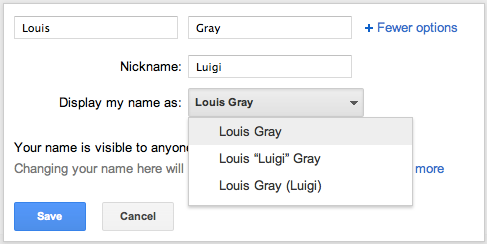Aliases allowed on Google+
Six months later, Google backed out and officially allowed us to use pseudonyms again in our social network. But not for everyone.

New rules for names in Google+ profiles allow nicknames, but there are several restrictions: numbers and symbols are prohibited, the use of someone else's nicknames is prohibited, and you can not change your nickname more than once every 30 days. At the moment, you can only use the nickname next to the name, while the indication of the real name remains mandatory.
')
To exclude a real name from your profile, you need to fill out a special form and provide Google with proof that you are widely known by this nickname. Articles in the press, scanned documents, etc. will be suitable as evidence. That is, pseudonyms are allowed only for so-called Established Identities, like Madonna or Umputun.
Recall that in July, Google began to block accounts that are not registered with a real name. The ban on pseudonyms has caused a storm of indignation from ordinary users, as well as from celebrities who are known on the Internet by nicknames (for example, MG Siegler).
Google backed out and suspended massive blocking. In October, Google’s senior vice president of social services, Vic Gundotra, promised to release “functionality with support for other forms of identification” in the next few months. And so it happened.
Google justifies such limited support for pseudonyms by internal statistics , according to which pseudonyms ask for registration only 0.1% of users. At the same time, 60% of them just want to add a nickname to the real name, and another 20% are companies that mistakenly started an account on an individual. It turns out that "pure anonymous" make up only 0.02% of Google+ audience.
Apparently, jwz was right after all. According to Jamie Zawinski, user identification is needed to sell an audience to advertisers.

New rules for names in Google+ profiles allow nicknames, but there are several restrictions: numbers and symbols are prohibited, the use of someone else's nicknames is prohibited, and you can not change your nickname more than once every 30 days. At the moment, you can only use the nickname next to the name, while the indication of the real name remains mandatory.
')
To exclude a real name from your profile, you need to fill out a special form and provide Google with proof that you are widely known by this nickname. Articles in the press, scanned documents, etc. will be suitable as evidence. That is, pseudonyms are allowed only for so-called Established Identities, like Madonna or Umputun.
Recall that in July, Google began to block accounts that are not registered with a real name. The ban on pseudonyms has caused a storm of indignation from ordinary users, as well as from celebrities who are known on the Internet by nicknames (for example, MG Siegler).
Google backed out and suspended massive blocking. In October, Google’s senior vice president of social services, Vic Gundotra, promised to release “functionality with support for other forms of identification” in the next few months. And so it happened.
Google justifies such limited support for pseudonyms by internal statistics , according to which pseudonyms ask for registration only 0.1% of users. At the same time, 60% of them just want to add a nickname to the real name, and another 20% are companies that mistakenly started an account on an individual. It turns out that "pure anonymous" make up only 0.02% of Google+ audience.
Apparently, jwz was right after all. According to Jamie Zawinski, user identification is needed to sell an audience to advertisers.
Source: https://habr.com/ru/post/136911/
All Articles